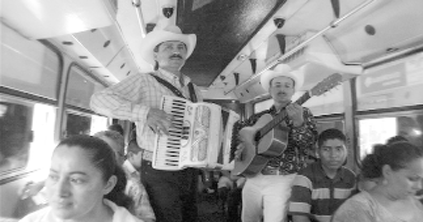Outlaw balladry frames compassionate canvas of border strife
Just when you thought the U.S.-Mexican border had been covered from every possible angle, along comes “Al Otro Lado (To the Other Side),” the debut documentary feature by Natalia Almada, to illuminate yet another facet—the louche world of narcocorridos, popular ballads of the drug trade.
Narcocorridos share a mongrel ancestry with Mexican cinema’s traficante subgenre, among other varieties of insurgent border culture. Musically, however, they stem from a two-century-old lineage of corridos that have functioned as a kind of oral gazette, encapsulating a whole history in their narrative stanzas—from folk hero Gregorio Cortez to the 1968 Tlatelolco student massacre to pillories of the Fox administration.
Not to be mistaken with Chantal Akerman’s border doc “To the Other Side,” “Al Otro Lado” centers on the cherubic Magdiel Rubio Burgos, an adept singer-songwriter of corridos who lives with his humble family in Sinaloa, on Mexico’s Pacific coast. His hopes and preparations to cross la línea, where he is certain showbiz fortune awaits, are the backbone for Almada’s survey of the narcocorrido scene, which in turn frames her reflections on transmigration and border conflict.
Proud that his corridos are the men’s favorite in the local prison, Magdiel throbs with musicality, compulsively jotting lyrics and belting lusty odes to smugglers and hombres valientes in a reedy tenor when not at sea helping his shrimp-fishing dad. He eagerly awaits the chance to be smuggled himself, by the coyotes with whom we see him hanging out; these guys nonchalantly admit they’d abandon their human cargo in the desert outback at the first sign of trouble or lag.
Magdiel’s crossover dreams are contrasted with the corrido megastars Los Tigres del Norte, whose dapper lead Jorge Hernandez relates how the group was baptized quite literally on the border, courtesy of a U.S. customs clerk at a checkpoint. Hernandez dispassionately notes the importance of the narcotics trade to the larger Mexican economy, and historian Luis Astorga chimes in to assert that drug runners really just want some of the dignity and material security the middle class takes for granted.
Almada suavely uses the cult of Jesús Malverde—the Porfiriate-era patron saint of bandits, engraved on belt buckles and amulets, supplicated in his own shrines—to introduce narcocorrido paragon Chalino Sanchez. A Sinaloan youth who avenged his sister’s rape with murder before migrating to Los Angeles at 17, Sanchez jobbed as a dishwasher and sometime coyote, gradually acquiring a hardcore rep—once trading gunfire from onstage with a would-be assassin—and achieving musical renown before his Mafia-style execution at age 31 cemented his legend among underclass Mexicans.
Sanchez is venerated by U.S.-born corridistas like Jessie Morales, whose flow is a syncretic smelting of banda and hip hop, or Jenni Rivera, who with brothers Lupillo and Juan front the Los Angeles-based Rivera musical dynasty, flush ever since daddy Pedro signed Chalino to their Cintas Acuario label. In concert, Jenni boasts, “My father taught me to sell the best merchandise… My gun should always be shiny.” Chalino shout-outs from sauced fans caught in nightclub parking lots add to the festal ambience.
These scenes attest to complex self-fashionings by second- to fifth-generation Chicanos intent on upholding their cultural singularity as they navigate between imperatives of the gringo mainstream and the urban ethnoscape, and will disarm provincial Gothamites who thought reggaetón was the last word in musical hybridity. Setting the commodification of this formerly grassroots music against Magdiel’s aspirations, Almada at once underscores his naïveté and deflates the swagger of Morales and Rivera.
In many quarters narcocorrido’s runaway popularity has cued familiar condemnations that the music’s glorified criminality fosters a nihilistic “culture of death,” especially among impressionable kiddies, leading to airplay bans among other symbolic measures. Official censorship, on top of the longstanding scorn for “uncouth” conjunto styles among many bourgeois Mexicans and Anglos alike, has of course only strengthened working-class identification with and pleasure in the music.
Yet Almada hardly flinches from the surrounding economic and human tragedies, taking us inside the Tucson morgue and a potter’s field for unidentified migrants, each wasted life marked by a numbered brick. And if you’ve ever wondered what a nonstop three-day trek through the desert might do to your feet, here you’ll find out. Near the end, Almada unforgettably witnesses a cell of armed xenophobe vigilantes capture a handful of terrified migrants, a sequence that will leave any sensate viewer apoplectic.
From the tension between these realities and the piquant cinematography by Chuy Chávez arises a furtive, incongruous elation. Shooting in 24P digital video for the optical semblance of pricier film, Chávez makes every composition snap but doesn’t gild harsh experiences. Rather, in the scenes of dance and song, he and Almada sensually suggest how narcocorrido’s devotees fancy themselves in their better moments—somewhat more beautiful and ennobled than life ordinarily allows.
Aptly, the film shuns resolution. Shortly before Magdiel sets off, he tells Almada he’s not packing any rainy-day funds and confesses he has no specific idea how he’ll proceed after he arrives; he’s never been there before, he deadpans. He and a motley group are pointed toward the Colorado River by a coyote, and in the end Almada abandons us to our conscience.
gaycitynews.com

































